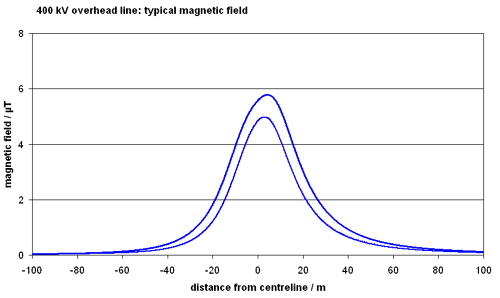

400 kV is the highest voltage in use in the UK.
Magnetic field
The maximum field is produced by the largest design of line – the L6 – when the ground clearance is the minimum allowed – 7.6 m – and the loads are the highest allowed – 4.7 kA in each circuit. The field also depends on the phasing. Transposed (T) is higher close to the line and Untransposed (U) is higher away from the line. This graph shows both .
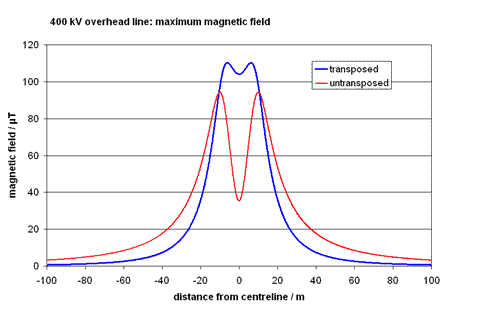
The maximum fields come from a design of line called the L6. This was used extensively when the transmission system was built in the 1960s and 70s. More recently, new 400 kV lines have often been built using a slightly smaller design of line, the L12. This produces smaller fields than the L6. We give here graphs showing the maximum fields from an L12 line at 400 kV.
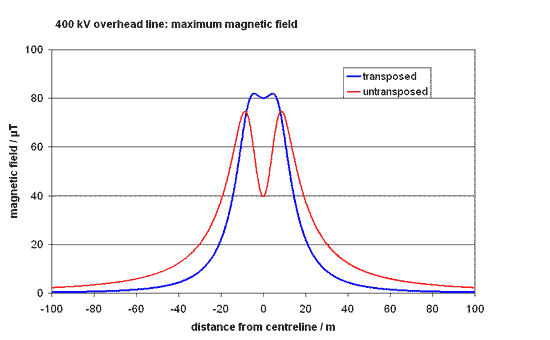
see also an example of unusually heavily loaded lines.
Typical fields are lower than the maximum field because the clearance is usually higher and the loads are usually lower. Also, many lines are a slightly smaller design – the L2. Both L6 and L2 are shown on the following graph. The phasing here is T as this is more common. It is rare for the two circuits to carry exactly the same load. That is why the magnetic field shown here is not symmetrical.
The data
This table gives some actual field values for the same conditions.
magnetic field in µT at distance from centreline | |||||||||
|---|---|---|---|---|---|---|---|---|---|
| maximum under line | 10 m | 25 m | 50 m | 100 m | |||||
| 400 kV | largest lines | L6 quad bundles 0.305 m zebra | maximum | clearance 7.6 m phasing U load 4.7/4.7 kA | 108.422 | 95.780 | 38.422 | 11.697 | 3.096 |
| typical | clearance 13 m phasing T load 0.4/0.6 kA | 5.783 | 5.247 | 2.194 | 0.578 | 0.119 | |||
| smaller lines | L2 twin bundles 0.305 m zebra | maximum | clearance 7.6 m phasing U load 2.4/2.4 kA | 54.142 | 46.300 | 16.283 | 4.865 | 1.278 | |
| typical | clearance 13 m phasing T load 0.4/0.6 kA | 4.971 | 4.158 | 1.557 | 0.400 | 0.084 | |||
| typical design used for new lines | L12 twin bundles 0.5 m araucaria | maximum | clearance 7.6 m phasing U load 3.5/3.5 kA | 81.942 | 72.818 | 22.103 | 8.148 | 2.145 | |
| typical | clearance 13 m phasing T load 0.4/0.6 kA | 5.604 | 4.938 | 1.979 | 0.514 | 0.106 | |||
Note:
1. All fields calculated at 1 m above ground level.
2. All fields are given to the same resolution for simplicity of presentation (1 nT = 0.001 µT) but are not accurate to better than a few percent.
3. Calculations ignore zero-sequence current. This means values at larger distances are probably underestimates, but this is unlikely to amount to more than a few percent and less closer to the line.
4. The “maximum field under the line” is the largest field, which is not necessarily on the route centreline; it is often under one of the conductor bundles.
Electric field
The maximum field is produced by the largest design of line – the L6 – when the ground clearance is the minimum allowed – 7.6 m. The field also depends on the phasing. Untransposed (U) is generally higher and is shown here. (see also the maximum field produced by the slightly smaller L12 line.)
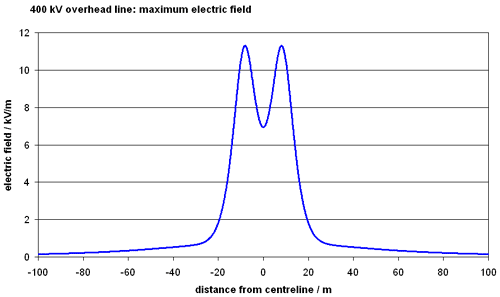
The maximum fields come from a design of line called the L6. This was used extensively when the transmission system was built in the 1960s and 70s. More recently, new 400 kV lines have often been built using a slightly smaller design of line, the L12. This produces smaller fields than the L6. We give here a graph showing the maximum fields from an L12 line at 400 kV.
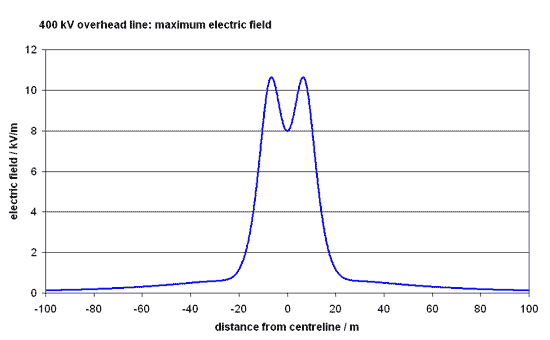
Typical fields are lower than the maximum field because the clearance is usually higher. Also, many lines are a slightly smaller design – the L2. Both L6 and L2 are shown on the following graph. The phasing here is transposed (T) as this is more common.
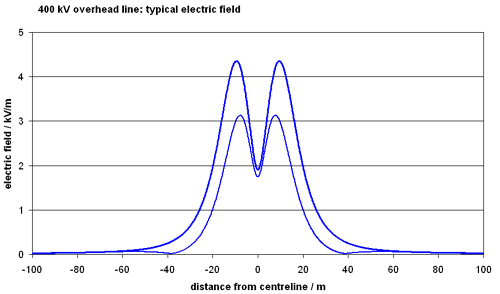
This table gives some actual field values for the same conditions.
electric field in V m-1 at distance from centreline | |||||||||
|---|---|---|---|---|---|---|---|---|---|
| maximum under line | 10 m | 25 m | 50 m | 100 m | |||||
| 400 kV | largest lines | L6 quad bundles 0.305 m zebra | maximum | clearance 7.6 m phasing U | 11400 | 10130 | 774 | 446 | 156 |
| typical | clearance 13 m phasing T | 4244 | 4206 | 962 | 106 | 32 | |||
| smaller lines | L2 twin bundles 0.305 m zebra | maximum | clearance 7.6 m phasing U | 9897 | 6618 | 283 | 357 | 118 | |
| typical | clearance 13 m phasing T | 3128 | 2964 | 469 | 56 | 27 | |||
| typical design used for new lines | L12 twin bundles 0.5 m araucaria | maximum | clearance 7.6 m phasing U | 10642 | 8410 | 669 | 404 | 136 | |
| clearance 7.6 m phasing T | 9384 | 7933 | 737 | 151 | 30 | ||||
| typical | clearance 13 m phasing T | 3704 | 3595 | 732 | 98 | 26 | |||
Note:
1. All fields calculated at 1 m above ground level.
2. All electric fields are calculated for the nominal voltage. In practice, voltages (and hence fields) may rise by a few percent.
3. All electric fields calculated here are unperturbed values.
4. All fields are given to the same resolution for simplicity of presentation (1 V/m) but are not accurate to better than a few percent.
5. Calculations ignore zero-sequence voltages. This means values at larger distances are probably underestimates, but this is unlikely to amount to more than a few percent and less closer to the line.
6. The “maximum field under the line” is the largest field, which is not necessarily on the route centreline; it is often under one of the conductor bundles.
7. In efforts to reduce aerodynamic problems, a small number of 400 kV lines with quad bundles have had expanded bundles fitted, e.g. 500 mm horizontally. This produces slightly higher electric fields but is not included in these tables.
Underground cables
Three main types of underground cable are used.
- Trough: the separate cores of the cable are in a concrete trough, typically only 0.3 m or less below ground, but also only 0.15 m apart
- Direct buried: the separate cores of the cable are laid directly in the ground, typically 1 m below ground and 0.3-0.5 m apart
- Tunnel: the cable is carried in a tunnel typically 20 m below ground
See photos and diagrams of these different types of cable and also details of a newer technology, Gas Insulated Lines, not yet used in the UK.
Cables in tunnels are so far below ground that the fields at ground level are usually below background levels. Maximum fields from typical examples of the other two types are shown in this graph. This is for 1 m above ground. At this height, the direct-buried cable produces the higher field. Closer to the ground, the trough produces the higher field. Fields from underground cables are very sensitive to the height above ground. more detail
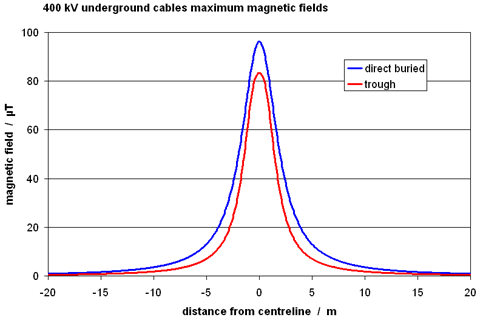
Typical fields are lower than the maximum field because the loads are usually lower. Typical fields are shown in the following graph.
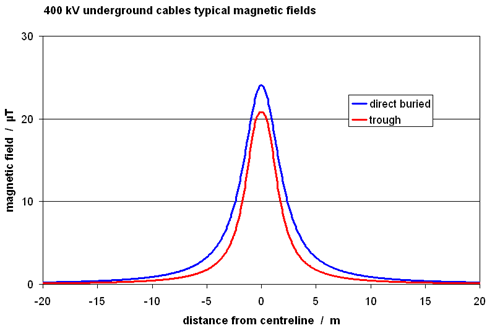
Underground cables do not produce any external electric fields.
Obtaining a higher rating with an underground cable can involve installing multiple groups of conductors - see how this affects the magnetic field.
This table gives some actual field values for the same conditions.
| magnetic field in microtesla at distance from centreline | |||||||
|---|---|---|---|---|---|---|---|
| 0 m | 5 m | 10 m | 20 m | ||||
| 400 kV | trough | 0.13 m spacing 0.3 m depth | maximum | 83.30 | 7.01 | 1.82 | 0.46 |
| typical | 20.83 | 1.75 | 0.46 | 0.12 | |||
| direct buried | 0.5 m spacing 0.9 m depth | maximum | 96.17 | 13.05 | 3.58 | 0.92 | |
| typical | 24.06 | 3.26 | 0.90 | 0.23 | |||
Notes
1. All fields calculated at 1 m above ground level
2. All fields are given to the same resolution for simplicity of presentation (0.01 µT = 10 nT) but are not accurate to better than a few percent.
3. Calculations ignore zero-sequence current. This means values at larger distances are probably underestimates, but this is unlikely to amount to more than a few percent.
4. Cable designs are not standardised to the same extent as overhead lines and the examples given here are representative.
5. The trough calculation is for a double circuit and the direct buried is for a single circuit, but in practice there may be other nearby circuits which affect the field.
Alternative designs of lines
This page deals with the great majority of lines so far, which are carried on lattice steel pylons. On a separate page, we give details of some special situations or new designs:
- the T-pylon
- low-height pylons
- single-circuit lines
- unusually heavily loaded lines
See also:
average fields calculated from one year of actual load data
These graphs are for lines carrying typical loads, but some lines carry larger loads - see here for an example
National Grid is consulting on an alternative pylon called the "T-pylon" - see here for the fields it produces
